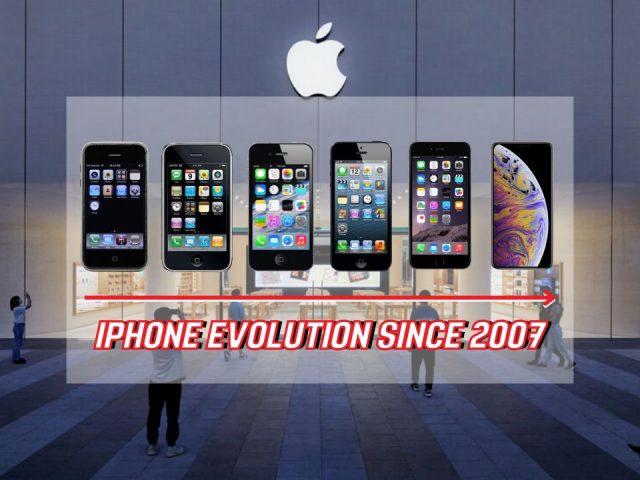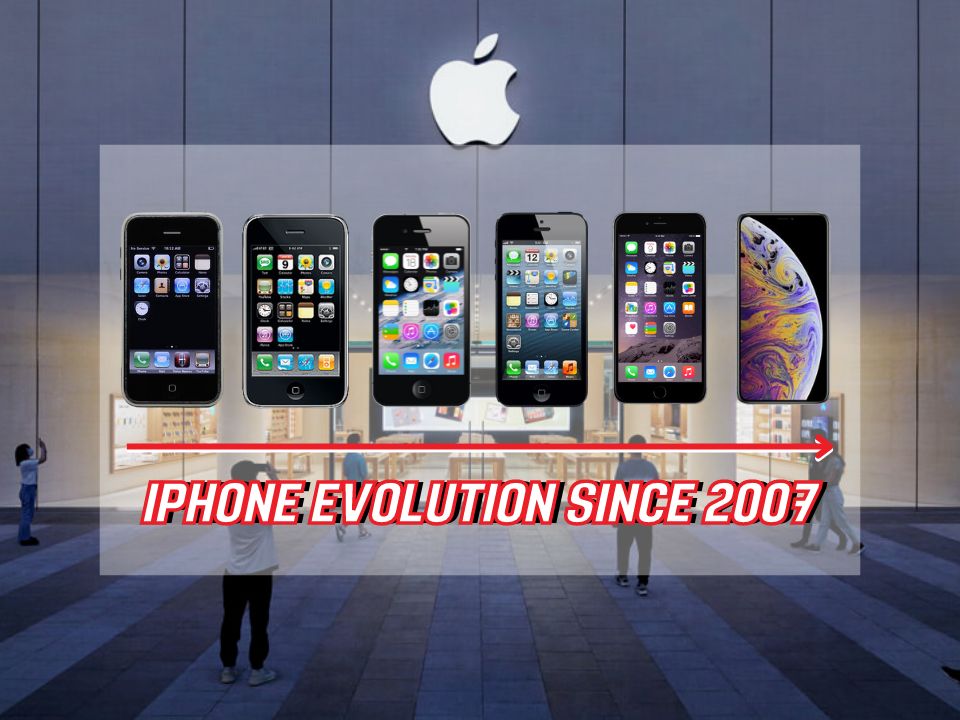
The original iPhone was introduced to the public on June 29, 2007, a few months after Steve Jobs made the announcement to launch a phone at the Macworld convention in January 2007. The iPhone which is part of the iPhone evolution was revolutionary because it was the first touch-screen phone with a built-in MP3 player (iPod) and a fully functional web browser.
iPhone Evolution Throughout The Years
An examination of the iPhone’s development from its 2007 introduction reveals insights into the device’s current status as a cultural icon. In this list, we dive into the Apple evolution as it changes gradually in terms of design, specifications over the last 15 years.
1. iPhone (2007)
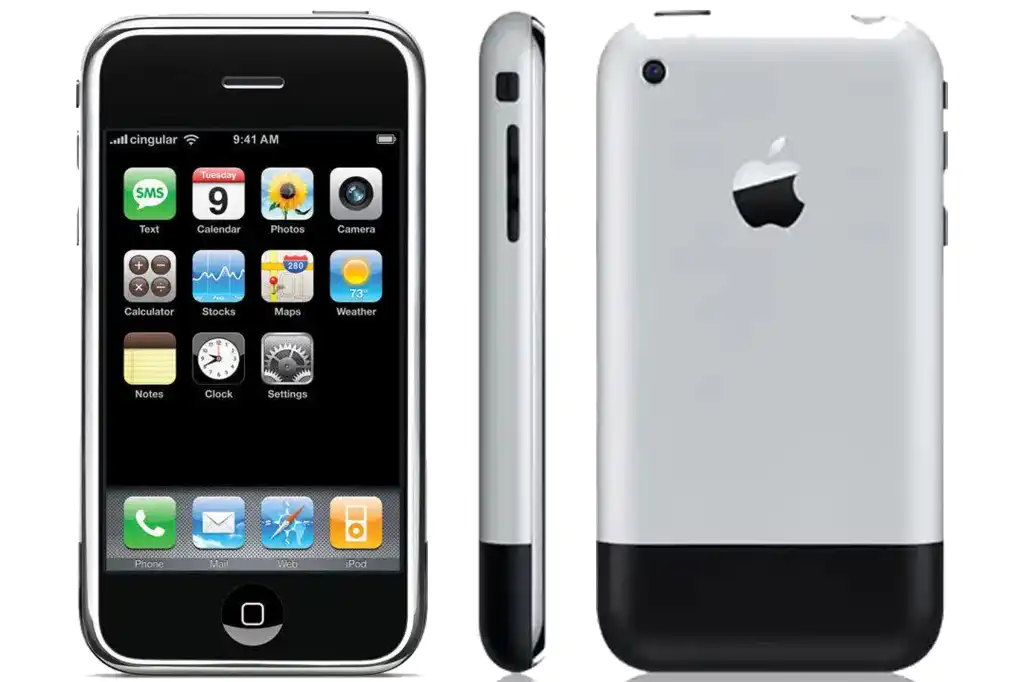
The Apple iPhone’s origin story begins in 2007, when Steve Jobs shocked the world by announcing a mysterious new product that would combine an iPod music player, an Internet communication device, and a standard phone all in one sleek package. That was the very first iPhone, created by Apple.
Specs:
- Released: 29 June 2007
- Display: 3.5 inches (480 x 320 pixels)
- Camera: 2 MP single camera
- Hardware: 0.1GB RAM
- Storage: 16GB
- Battery: 1400 mAh
- Operating system: iOS 3.x
2. iPhone 3G (2008)
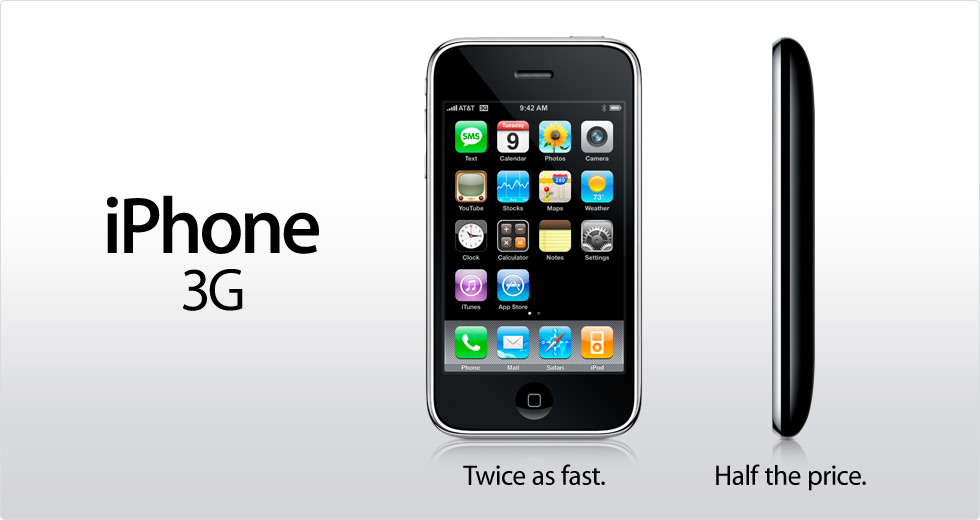
The iPhone 3G’s screen size remained the same as the original, but it adopted a new, glossy plastic body and gained 3G connectivity, allowing for substantially quicker online page loads. The Global Positioning System (GPS) was initially introduced on the iPhone 3G, making it possible for users to get a more accurate sense of where they were at any given time.
Specs:
- Released: 11 July 2008
- Display: 3.5 inches (480 x 320 pixels)
- Camera: 2 MP single camera
- Hardware: 0.1GB RAM
- Storage: 16GB
- Battery: 1150 mAh
- Operating system: iOS 4.x
3. iPhone 3GS (2009)
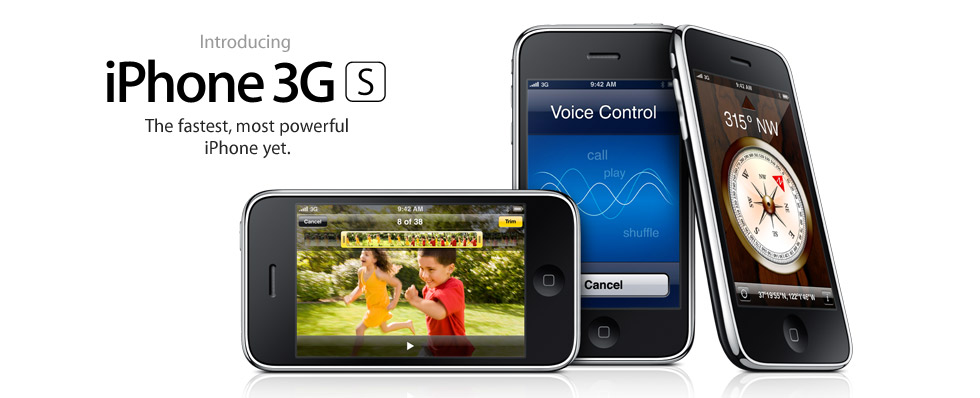
iPhone evolution evolved internally this time where It was the first iPhone to be able to record video, hence the “S” in “3GS,” and it was also more powerful and quicker. Video recording at VGA (480p) resolution was introduced with the new 3-megapixel camera in the iPhone 3GS.
Specs:
- Released: 19 June 2009
- Display: 3.5 inches (480 x 320 pixels)
- Camera: 3 MP single camera
- Hardware: 0.25GB RAM
- Storage: 32GB
- Battery: 1219 mAh
- Operating system: iOS 6.1x
4. iPhone 4 (2010)
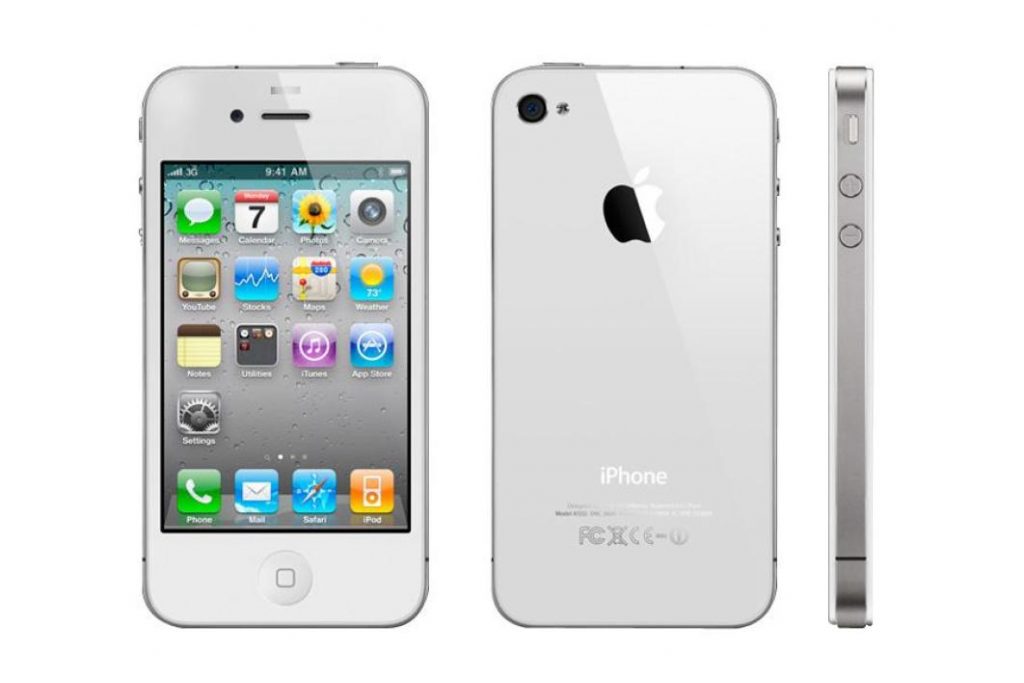
From the look iPhone evolution, numerous Apple customers felt that the iPhone 4 had the best overall design of any iPhone. The iPhone 4 had a revolutionary glass design and metal frame, marking the first substantial redesign in the iPhone series. As the first iPhone to use Apple’s revolutionary ‘Retina’ display, its resolution of 640 x 960 pixels was so high that the company claimed it was on par with the human retina’s maximum pixel density.
Specs:
- Released: 24 June 2010
- Display: 3.5 inches (960 x 640 pixels)
- Camera: 5 MP single camera with 0.3 MP VGA front
- Hardware: Apple A4 0.5GB RAM
- Storage: 32GB
- Battery: 1420 mAh
- Operating system: iOS 7.x
5. iPhone 4S (2011)
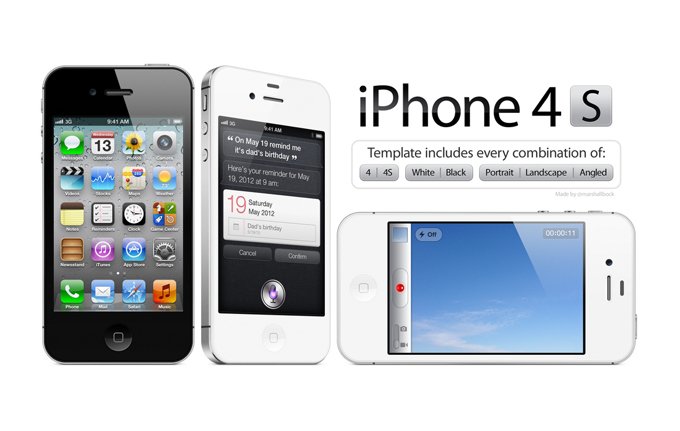
Siri, the iPhone 4s’s impressive smart voice assistant, stole the show with its witty questioning and ability to provide comic relief in times of need. It allowed for the setting of reminders and calendar events.
Specs:
- Released: 14 October 2011
- Display: 3.5 inches (960 x 640 pixels)
- Camera: 8 MP single camera with 0.3 MP VGA front
- Hardware: Apple A5 0.5GB RAM
- Storage: 64GB
- Battery: 1420 mAh
- Operating system: iOS 9.x
6. iPhone 5 (2012)
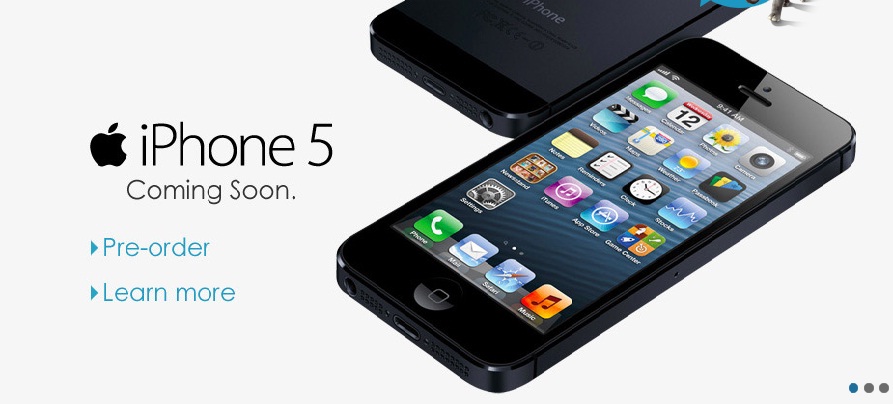
Apple evolution evolved in more of a sleek look this year when the iPhone 5’s screen increased in size from 3.5 inches to 4 inches and adopted a 16:9 aspect ratio (instead of the 3:2 ratio used previously), making it more suited for watching videos, which are almost always shot in that aspect ratio.
Specs:
- Released: 21 September 2012
- Display: 4 inches (1136 x 640 pixels)
- Camera: 8 MP single camera with 1.2 MP front
- Hardware: Apple A6 1GB RAM
- Storage: 64GB
- Battery: 1440 mAh
- Operating system: iOS 10.x
7. iPhone 5C & 5S (2013)
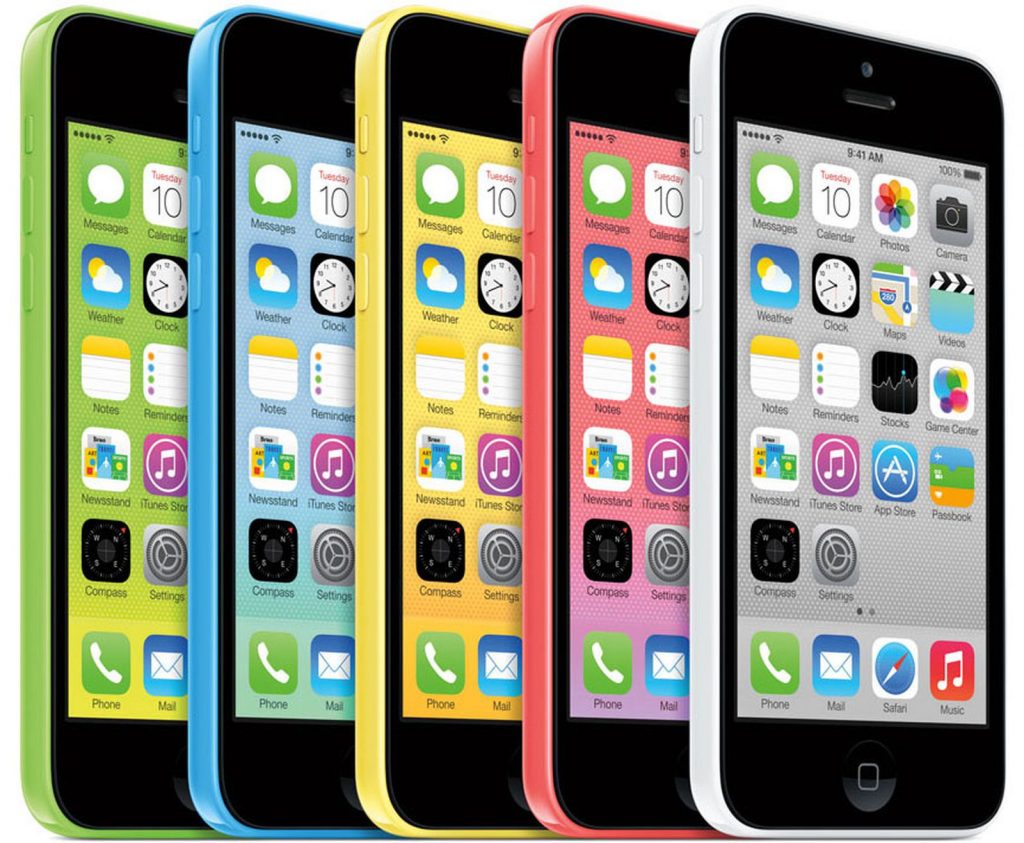
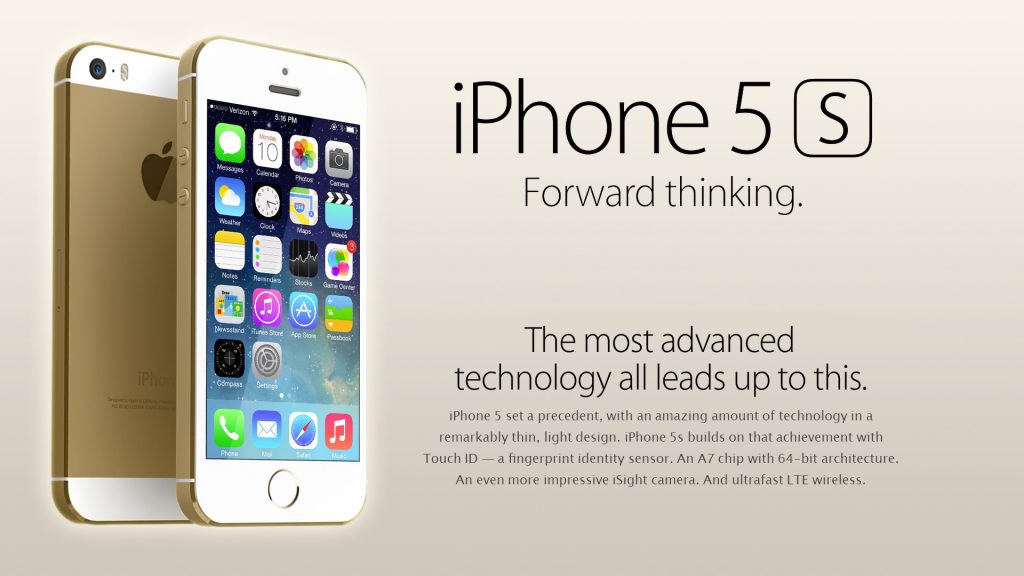
Still, the new Apple A7 ‘Cyclone’ CPU was the first 64-bit chip in a phone, years before others had even begun working on 64-bit chips, and the fingerprint-based secure authentication system, ‘Touch ID,’ would take years to effectively implement on Android phones, making this an essential ‘S’ update.
Not to be forgotten is Apple’s low-priced iPhone 5c, which sold well due to its bright colours and plastic construction, hence, this was considered to be part of iPhone evolution from a positive angle and green environment friendly.
Specs of iPhone 5C:
- Released: 20 September 2013
- Display: 4 inches (1136 x 640 pixels)
- Camera: 8 MP single camera with 1.2 MP front
- Hardware: Apple A6 1GB RAM
- Storage: 32GB
- Battery: 1507 mAh
- Operating system: iOS 10.x
Specs of iPhone 5S:
- Released: 20 September 2013
- Display: 4 inches (1136 x 640 pixels)
- Camera: 8 MP single camera with 1.2 MP front
- Hardware: Apple A7 1GB RAM
- Storage: 32GB
- Battery: 1507 mAh
- Operating system: iOS 12.x
8. iPhone 6 & 6 Plus (2014)
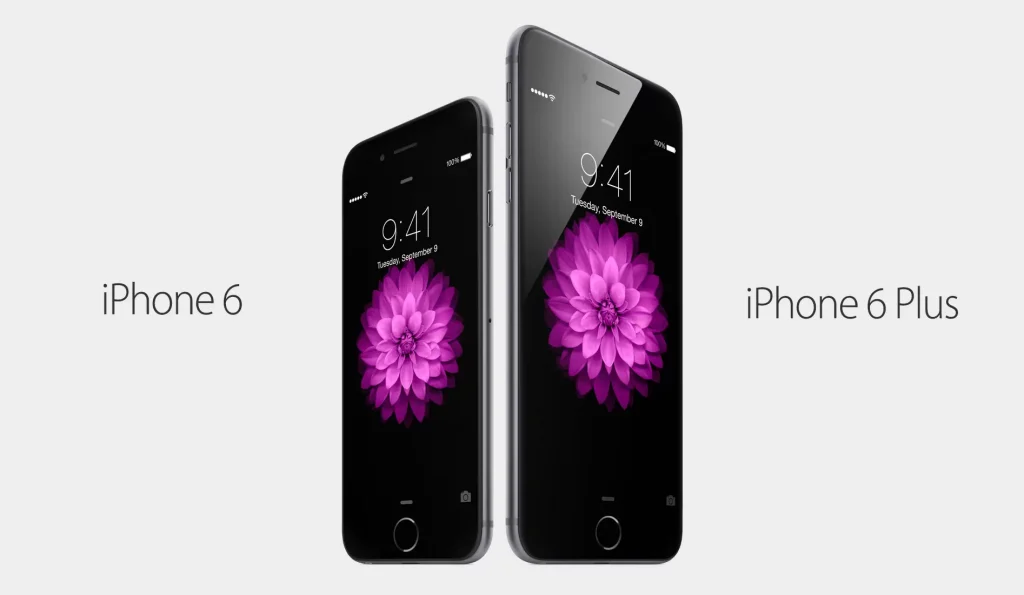
Another new move from the course of Apple evolution, the long wait for an iPhone with a larger display ended in 2014, when Apple unveiled the long-awaited iPhone 6. Both the 4.7-inch iPhone 6 and the 5.5-inch iPhone 6 Plus were available.
With a sleek and lightweight aluminium body, the pair sold like hotcakes thanks to its superior design. You can claim with confidence that the iPhone 6 paved the way for premium metal builds to become the norm for flagship devices.
Specs of iPhone 6:
- Released: 19 September 2014
- Display: 4.7 inches (1134 x 750 pixels)
- Camera: 8 MP single camera with 1.2 MP front
- Hardware: Apple A8 1GB RAM
- Storage: 16GB, 32GB, 64GB & 128GB
- Battery: 1810 mAh
- Operating system: iOS 12.x
Specs of iPhone 6 Plus:
- Released: 19 September 2014
- Display: 5.5 inches (1920 x 1080 pixels)
- Camera: 8 MP single camera with 1.5 MP front
- Hardware: Apple A8 1GB RAM
- Storage: 16GB, 32GB, 64GB & 128GB
- Battery: 2915 mAh
- Operating system: iOS 12.x
9. iPhone 6S & 6S Plus (2015)
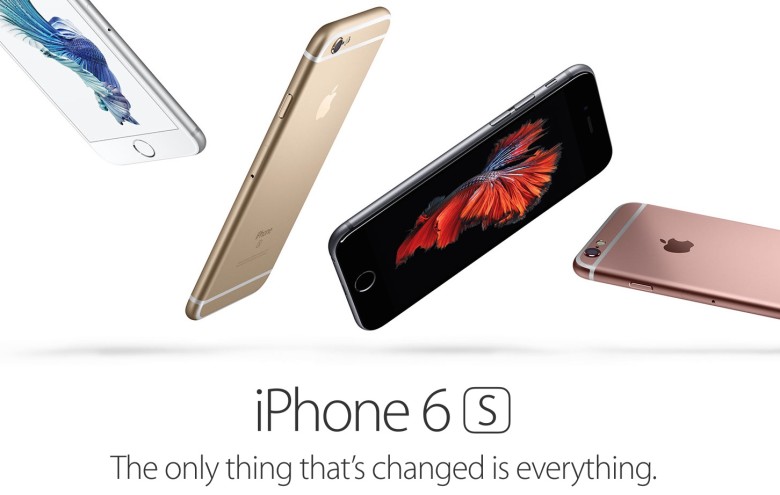
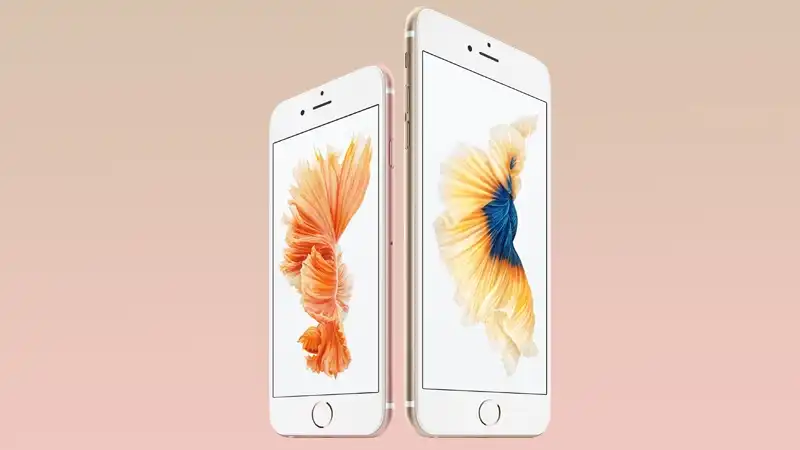
For the first time, Apple’s iPhone 6s and 6s Plus could capture 4K video. Even though the iPhone 6s was released late, Apple made sure to get all the important details perfect. The phone’s video quality was great, and it was captured at high bit rates. Many laptops at the time couldn’t edit 4K footage, yet a smartphone could.
Specs of iPhone 6S:
- Released: 25 September 2015
- Display: 4.7 inches (1134 x 750 pixels)
- Camera: 12 MP single camera with 5 MP front
- Hardware: Apple A9 2GB RAM
- Storage: 32GB, 64GB & 128GB
- Battery: 1715 mAh
- Operating system: iOS 15.x
Specs of iPhone 6S Plus:
- Released: 25 September 2015
- Display: 5.5 inches (1920 x 1080 pixels)
- Camera: 12 MP single camera with 5 MP front
- Hardware: Apple A9 2GB RAM
- Storage: 32GB, 64GB & 128GB
- Battery: 2750 mAh
- Operating system: iOS 15.x
10. iPhone SE (2016)

On this segment of iPhone evolution, the first iPhone SE delighted fans of tiny phones by returning to Apple’s tried-and-true 4-inch design factor.
What made it truly revolutionary, however, was its price: at $400 (RM1750+) for the base 16GB model, it was the first truly affordable iPhone.
Specs of iPhone SE:
- Released: 31 March 2016
- Display: 4 inches (1136 x 640 pixels)
- Camera: 12 MP single camera with 1.2 MP front
- Hardware: Apple A9 2GB RAM
- Storage: 32GB, 64GB & 128GB
- Battery: 1624 mAh
- Operating system: iOS 14.x
11. iPhone 7 & 7 Plus (2016)
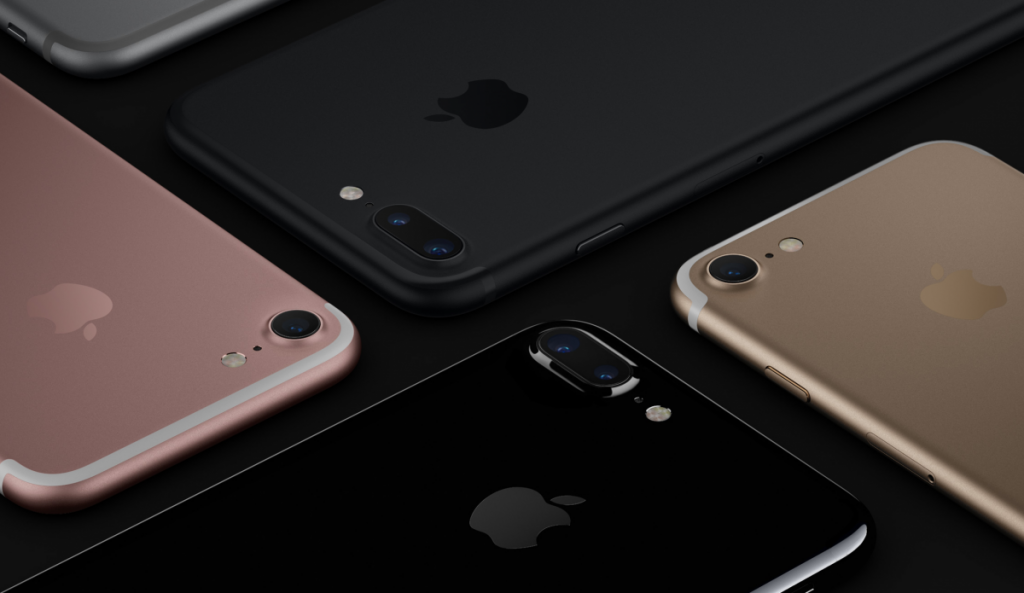
The iPhone evolution made another small change where Apple removed the headphone jack and water-proofed both iPhones in 2017. The camera Apple “courageously” destroyed the 3.5mm headphone jack. The iPhone 7 broke all Apple sales records, but the backlash was immense.
Specs of iPhone 7:
- Released: 19 September 2014
- Display: 4.7 inches (1134 x 750 pixels)
- Camera: 12 MP single camera with 7 MP front
- Hardware: A10 Fusion 2GB RAM
- Storage: 16GB, 32GB, 64GB, 128GB & 256GB
- Battery: 1960 mAh
- Operating system: iOS 15.x
Specs of iPhone 7 Plus:
- Released: 19 September 2014
- Display: 5.5 inches (1920 x 1080 pixels)
- Camera: 12 MP dual cameras with 7 MP front
- Hardware: A10 Fusion 2GB RAM
- Storage: 16GB, 32GB, 64GB, 128GB & 256GB
- Battery: 2900 mAh
- Operating system: iOS 15.x
12. iPhone 8 & 8 Plus (2017)
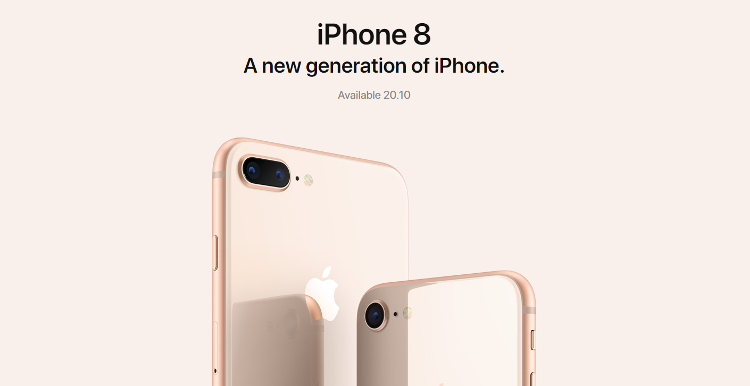
You must still think about how the size will effect your regular use of the phone despite the obvious size difference. For instance, the iPhone 8 is more pleasant to hold and fits into pockets better if you have a narrower grip. The larger iPhone 8 Plus provides a more immersive experience if you play games and watch a lot of video. Images on the iPhone 8 Plus are also slightly clearer, even if you might not be able to see with your naked eye because to the iPhone 8 Plus’ higher resolution and pixel density.
Specs of iPhone 8:
- Released: 22 September 2017
- Display: 4.7 inches (1134 x 750 pixels)
- Camera: 12 MP single camera with 7 MP front
- Hardware: A11 Bionic 2GB RAM
- Storage: 16GB, 32GB, 64GB, 128GB & 256GB
- Battery: 1821 mAh
- Operating system: iOS 16.x
Specs of iPhone 8 Plus:
- Released: 22 September 2017
- Display: 5.5 inches (1920 x 1080 pixels)
- Camera: 12 MP single camera with 7 MP front
- Hardware: A11 Bionic 3GB RAM
- Storage: 16GB, 32GB, 64GB, 128GB & 256GB
- Battery: 2691 mAh
- Operating system: iOS 16.x
13. iPhone X (2017)
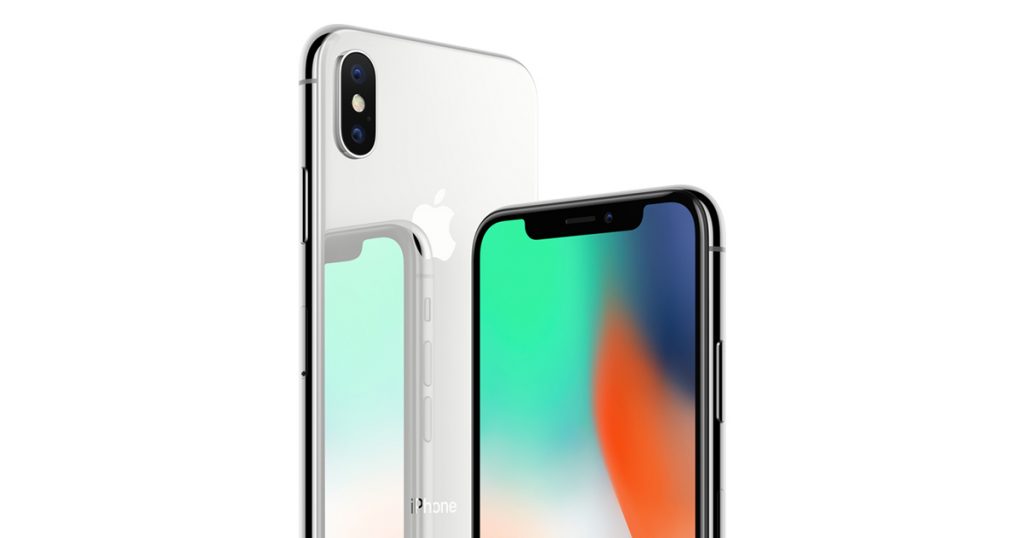
2017 marked the year of somehow Apple evolution changed drastically, since it was the first iPhone with an OLED display and a bezel-less edge-to-edge screen (yes, with the notch), the iPhone X truly set the standard for future iPhones. The brand-new Face ID system that detected your face proved to be more secure and user-friendly, which also spelled the end of Touch ID fingerprint recognition.
Specs of iPhone X:
- Released: 3 November 2017
- Display: 5.8 inches (2436 x 1125 pixels)
- Camera: 12 MP single camera with 12 MP front
- Hardware: A11 Bionic 3GB RAM
- Storage: 64GB & 256GB
- Battery: 2716 mAh
- Operating system: iOS 16.x
14. iPhone XR (2018)

The back of the XR features a brand-new design in a rainbow of colours. The iPhone XR’s bigger bezels up front and LCD screen technology with a relatively low HD+ resolution preserved the same fast processor as on the XS series here and also used the very same main camera, helping it become the best-selling iPhone of the series alongside the attractiveness of the iOS ecosystem.
Specs of iPhone XR:
- Released: 26 October 2018
- Display: 6.1 inches (828 x 1792 pixels)
- Camera: 12 MP single camera with 7 MP front
- Hardware: A12 Bionic 3GB RAM
- Storage: 64GB, 128GB & 256GB
- Battery: 2942 mAh
- Operating system: iOS 16.x
15. iPhone XS & XS Max (2018)
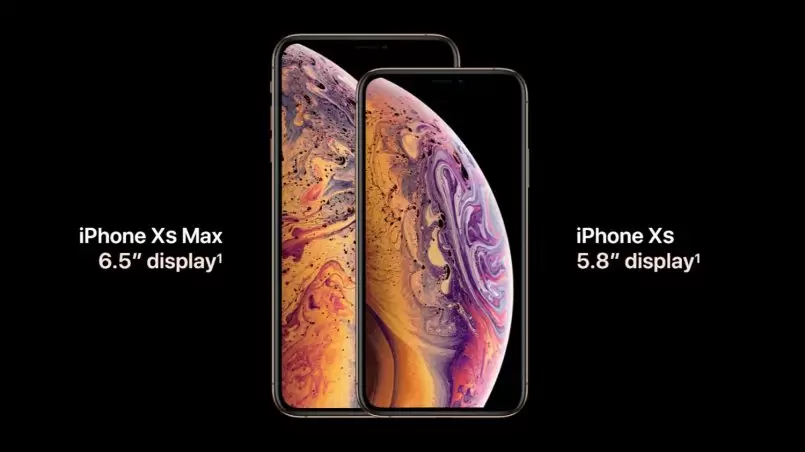
Following the precedent set by the iPhone X of the previous iPhone evolution, Apple released the iPhone XS and XS Max, both of which included a dual camera system with a primary and a 2X zoom telephoto lens and retailed for $1,000 or more.
Specs of iPhone XS:
- Released: 21 September 2018
- Display: 5.8 inches (1125 x 2436 pixels)
- Camera: 12 MP single camera with 7 MP front
- Hardware: A12 Bionic 4GB RAM
- Storage: 64GB, 256GB & 512GB
- Battery: 2658 mAh
- Operating system: iOS 16.x
Specs of iPhone XS:
- Released: 21 September 2018
- Display: 6.5 inches (1242 x 2688 pixels)
- Camera: 12 MP single camera with 7 MP front
- Hardware: A12 Bionic 4GB RAM
- Storage: 64GB, 256GB & 512GB
- Battery: 3174 mAh
- Operating system: iOS 16.x
16. iPhone 11, 11 Pro & 11 Pro Max (2019)
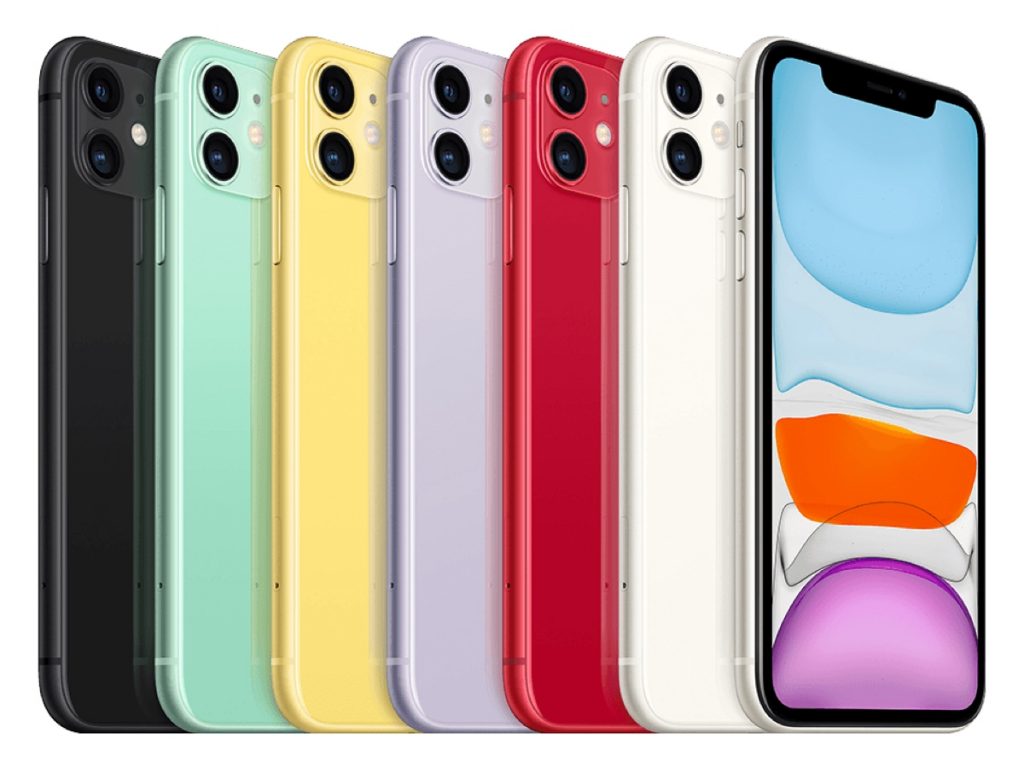
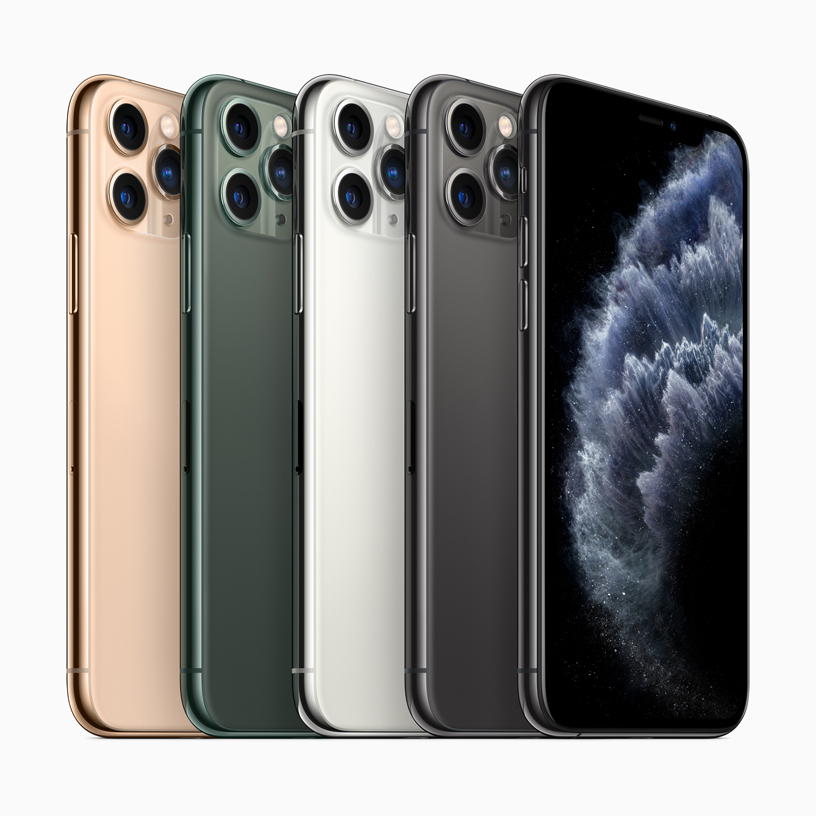
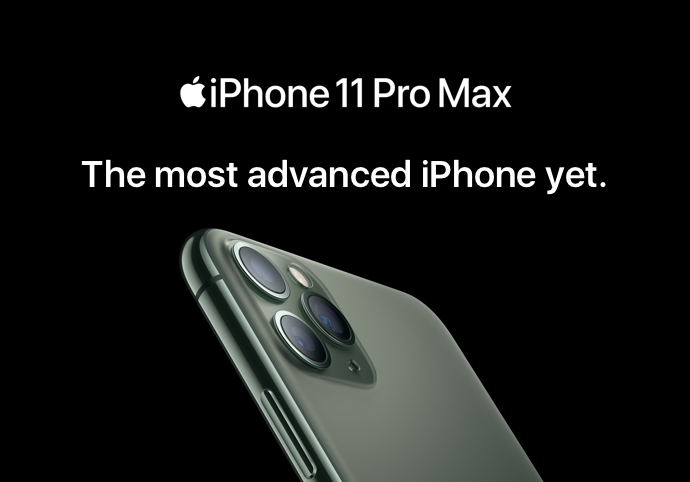
Three new iPhones were released by Apple in 2019, and they were very similar to the devices released in 2018.
The most significant update of this iPhone evolution was made to the camera, and all three models of the iPhone now come equipped with a brand-new ultra-wide camera that enables users to take stunning landscape images as well as pictures in confined areas.
Specs of iPhone 11:
- Released: 20 September 2019
- Display: 6.1 inches (828 x 1792 pixels)
- Camera: 12 MP single camera with 12 MP front
- Hardware: A13 Bionic 4GB RAM
- Storage: 64GB, 128GB & 256GB
- Battery: 3110 mAh
- Operating system: iOS 16.x
Specs of iPhone 11 Pro:
- Released: 20 September 2019
- Display: 5.8 inches (1125 x 2436 pixels)
- Camera: 12 MP single camera with 12 MP front
- Hardware: A13 Bionic 4GB RAM
- Storage: 64GB, 128GB, 256GB & 512GB
- Battery: 3046 mAh
- Operating system: iOS 16.x
Specs of iPhone 11 Max:
- Released: 20 September 2019
- Display: 6.5 inches (1242 x 2688 pixels)
- Camera: 12 MP single camera with 12 MP front
- Hardware: A13 Bionic 4GB RAM
- Storage: 64GB, 128GB, 256GB & 512GB
- Battery: 3969 mAh
- Operating system: iOS 16.x
17. iPhone SE (2020)

When Apple revived the SE name in early 2020, it was right about the time the coronavirus pandemic was unleashed, dealing major blows to the economy. It was one of the most affordable among other iPhone models and significantly more powerful than any Android phone at the time, also was powered by Apple’s latest at the time A13 CPU.
Specs of iPhone SE (2020):
- Released: 24 April 2020
- Display: 4.7 inches (750 x 1334 pixels)
- Camera: 12 MP single camera with 7 MP front
- Hardware: A13 Bionic 3GB RAM
- Storage: 64GB, 128GB & 256GB
- Battery: 1821 mAh
- Operating system: iOS 16.x
18. iPhone 12 mini, 12, 12 Pro & 12 Pro Max (2020)
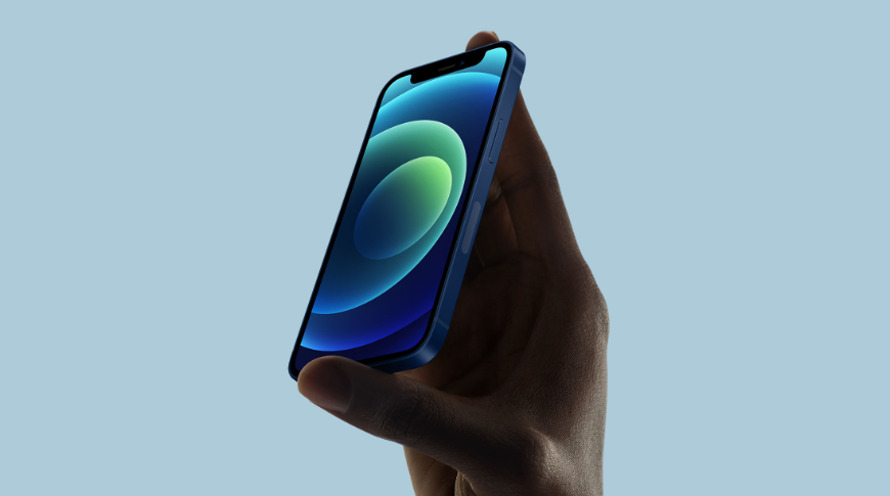
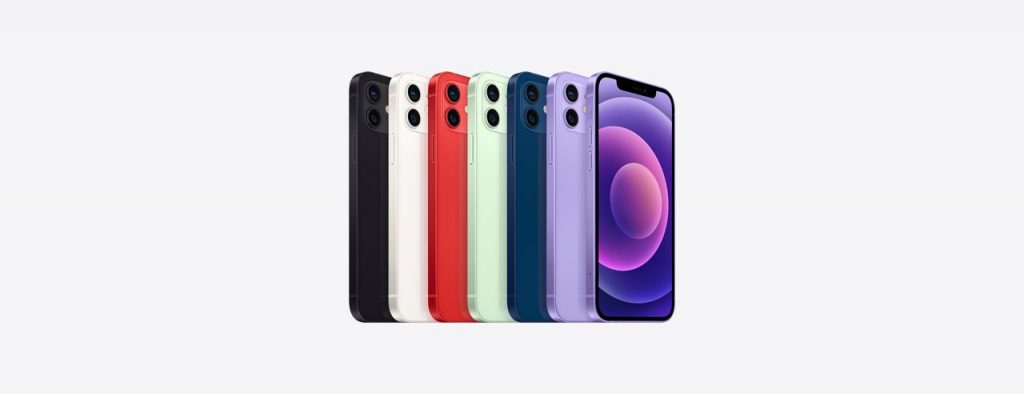

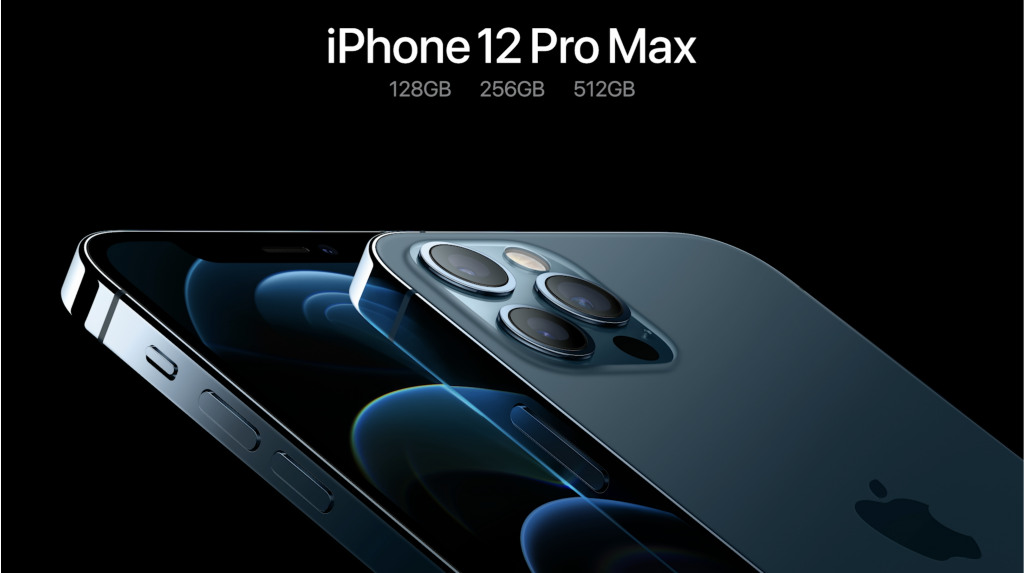
It wasn’t until late 2020 that Apple released four new iPhone models simultaneously. The iPhone 12 series marked a significant departure of iPhone evolution in terms of design from previous iterations, with features including a flatter front and back, thinner bodies, and the introduction of a new, more compact form factor with the iPhone 12 Mini.
Specs of iPhone 12 Mini:
- Released: 13 November 2020
- Display: 5.4 inches (1080 x 2340 pixels)
- Camera: 12 MP single camera with 7 MP front
- Hardware: A14 Bionic 4GB RAM
- Storage: 64GB, 128GB & 256GB
- Battery: 2227 mAh
- Operating system: iOS 16.x
Specs of iPhone 12:
- Released: 23 October 2020
- Display: 6.1 inches (1170 x 2532 pixels)
- Camera: 12 MP single camera with 7 MP front
- Hardware: A14 Bionic 4GB RAM
- Storage: 64GB, 128GB & 256GB
- Battery: 2815 mAh
- Operating system: iOS 16.x
Specs of iPhone 12 Pro:
- Released: 23 October 2020
- Display: 6.1 inches (1170 x 2532 pixels)
- Camera: 12 MP single camera with 7 MP front
- Hardware: A14 Bionic 6GB RAM
- Storage: 64GB, 128GB, 256GB & 512GB
- Battery: 2815 mAh
- Operating system: iOS 16.x
Specs of iPhone 12 Pro Max:
- Released: 13 November 2020
- Display: 6.7 inches (1284 x 2778 pixels)
- Camera: 12 MP single camera with 7 MP front
- Hardware: A14 Bionic 6GB RAM
- Storage: 64GB, 128GB, 256GB & 512GB
- Battery: 3687 mAh
- Operating system: iOS 16.x
19. iPhone 13 Mini, 13, 13 Pro & 13 Pro Max (2021)
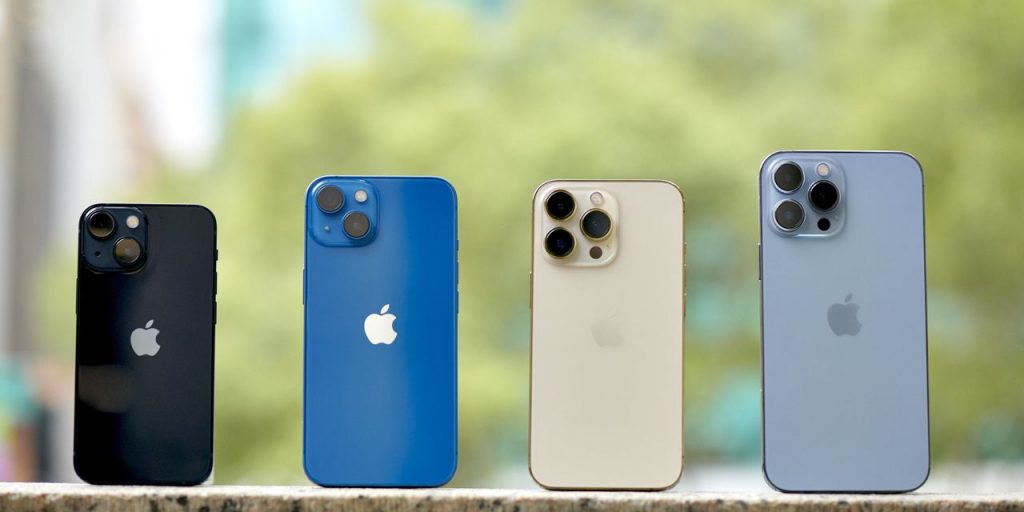
There was a worldwide scarcity of chips, yet Apple nonetheless managed to release all four models of the iPhone 13 series simultaneously. A 5.4-inch “mini,” two 6.1-inch “iPhones,” and a 6.7-inch “Pro Max” have remained staples in the series.
Specs of iPhone 13 Mini:
- Released: 24 September 2021
- Display: 5.4 inches (1080 x 2340 pixels)
- Camera: 12 MP single camera with 12 MP front
- Hardware: A15 Bionic 4GB RAM
- Storage: 128GB, 256GB & 512GB
- Battery: 2438 mAh
- Operating system: iOS 16.x
Specs of iPhone 13:
- Released: 24 September 2021
- Display: 6.1 inches (1170 x 2532 pixels)
- Camera: 12 MP single camera with 12 MP front
- Hardware: A15 Bionic 4GB RAM
- Storage: 128GB, 256GB & 512GB
- Battery: 3240 mAh
- Operating system: iOS 16.x
Specs of iPhone 13 Pro:
- Released: 24 September 2021
- Display: 6.1 inches (1170 x 2532 pixels)
- Camera: 12 MP single camera with 12 MP front
- Hardware: A15 Bionic 6GB RAM
- Storage: 128GB, 256GB, 512GB & 1TB
- Battery: 3095 mAh
- Operating system: iOS 16.x
Specs of iPhone 13 Pro Max:
- Released: 24 September 2021
- Display: 6.7 inches (1284 x 2778 pixels)
- Camera: 12 MP single camera with 12 MP front
- Hardware: A15 Bionic 6GB RAM
- Storage: 128GB, 256GB, 512GB & 1TB
- Battery: 4352 mAh
- Operating system: iOS 16.x
20. iPhone SE (2022)
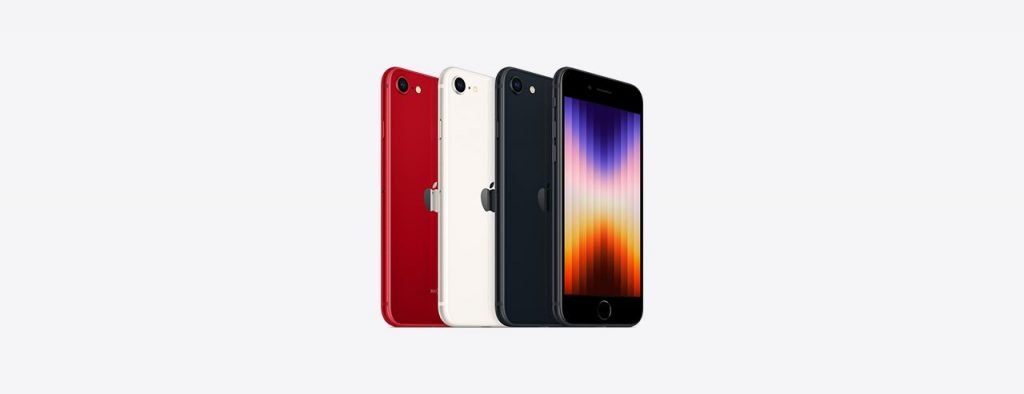
Before its release, this iPhone didn’t inspire high aspirations or a lot of buzz; in reality, it was a somewhat underwhelming upgrade. The SE (2022) has the same physical appearance as the first iPhone SE, which was introduced in 2014 alongside the iPhone 6.
Specs of iPhone SE (2022):
- Released: 18 March 2022
- Display: 4.7 inches (750 x 1334 pixels)
- Camera: 12 MP single camera with 7 MP front
- Hardware: A15 Bionic 4GB RAM
- Storage: 64GB, 128GB & 256GB
- Battery: 2018 mAh
- Operating system: iOS 16.x
21. iPhone 14, 14 Plus, 14 Pro & 14 Pro Max (2022)
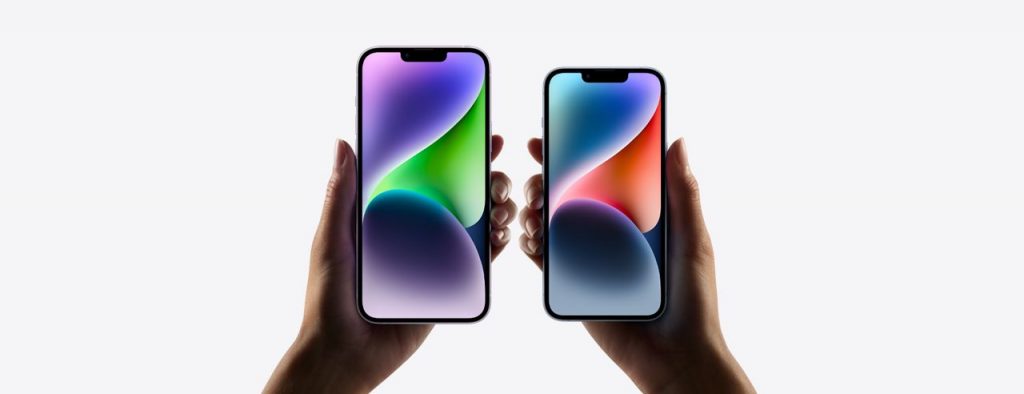
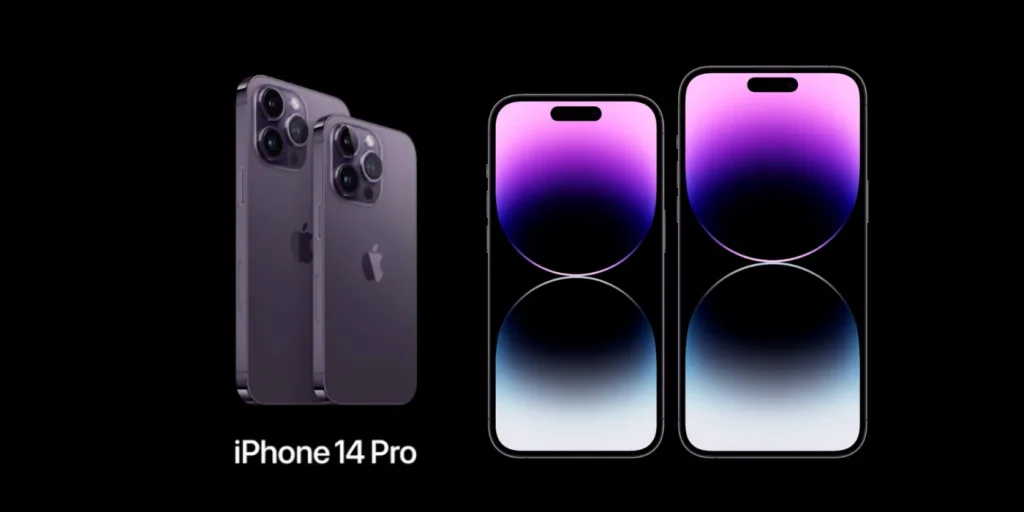
Last but not least in this list of Apple evolution, This iteration marks the first time that the Pro models receive the updated Apple A16 processor while the other models continue to use the older Apple A15.
The standard edition is largely unchanged in appearance, whereas the Pros feature more substantial upgrades. Rather than a cutout for the front-facing camera, the new Dynamic Island design features a pill-shaped camera module. It’s creative, well-animated, and fluid; the bubbles and pops represent alerts and notifications.
Specs of iPhone 14:
- Released: 16 September 2022
- Display: 6.1 inches (1170 x 2532 pixels)
- Camera: 12 MP single camera with 12 MP front
- Hardware: A15 Bionic 6GB RAM
- Storage: 128GB, 256GB & 512GB
- Battery: 3279 mAh
- Operating system: iOS 16.x
Specs of iPhone 14 Plus:
- Released: 7 October 2022
- Display: 6.7 inches (1284 x 2778 pixels)
- Camera: 12 MP single camera with 12 MP front
- Hardware: A15 Bionic 6GB RAM
- Storage: 128GB, 256GB & 512GB
- Battery: 4323 mAh
- Operating system: iOS 16.x
Specs of iPhone 14 Pro:
- Released: 16 September 2022
- Display: 6.1 inches (1179 x 2556 pixels)
- Camera: 48 MP single camera with 12 MP front
- Hardware: A16 Bionic 6GB RAM
- Storage: 128GB, 256GB, 512GB & 1TB
- Battery: 3200 mAh
- Operating system: iOS 16.x
Specs of iPhone 14 Pro Max:
- Released: 16 September 2022
- Display: 6.7 inches (1290 x 2796 pixels)
- Camera: 48 MP single camera with 12 MP front
- Hardware: A16 Bionic 6GB RAM
- Storage: 128GB, 256GB, 512GB & 1TB
- Battery: 4323 mAh
- Operating system: iOS 16.x
And that’s a wrap for the list of iPhone evolution since 2007. Apple’s iPhone evolution may not go through huge yet drastic changes but it’s still keeping in tact with fans and those who are actively seeking iPhone as their essential technological devices.
Interested to learn more about Apple products, visit their website.




